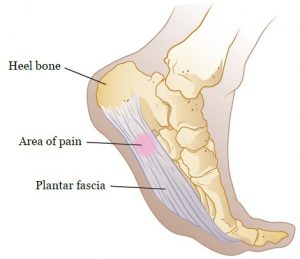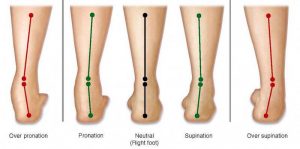
What is core?
September 1, 2019
Plantar fasciitis or fasciopathy
September 17, 2019Foot Biomechanics for Running
Before examining the biomechanics of walking and running, you should have some understanding of the anatomy of the lower limb. Your foot has 26 bones; between the ankle and the hip are 4 more bones—tibia, fibula, patella, and femur. These 30 bones on each side (60 in all) form the skeleton of the lower limb.
The Foot has three main components, heel, midfoot, forefoot. The foot controls how we walk and run, if part of the foot isn’t moving correctly then we can end up with pain due to poor biomechanics of the foot. Most movement should come from the midfoot, which is generally seen to control pronation and supination of the foot.
Pronation refers to the inward roll of the foot during normal motion and occurs as the outer edge of the heel strikes the ground and the foot rolls inward and flattens out. A moderate amount of pronation is required for the foot to function properly, however damage and injury can occur during excessive or over pronation.
Supination (or under-pronation) is the opposite of pronation and refers to the outward roll of the foot during normal motion. A natural amount of supination occurs during the push-off phase of the running gait as the heel lifts off the ground and the forefoot and toes are used to propel the body forward.
Biomechanics of Lower Limb When Running 
When running we should be aiming to put most pressure (landing) through mid and forefoot, avoiding heel striking (landing on heel first). Aiming to land on the mid and forefoot will spread the load throughout the foot then up the rest of the lower limb to the hip, this is its role. By doing this it acts almost like a suspension to your lower limb and allows the body to utilise hip, knee, calf and foot muscles to respond in a positive way, creating equal loads through the lower limb, as the foot contacts the floor.
If you first land (strike) on the heel then you are not allowing the body to use its natural suspension mechanisms therefore body must compensate by sending the load up through the lower limb, which can cause many different problems.
Common Injuries to The Foot in Runners
There are many different injuries you can sustain with poor running biomechanics, both in the foot, lower leg, knee and hip. Common issues can include;
- Plantar fasciitis and arch pain
- Ankle sprains
- Shin splints
- Achilles tendinitis
- Heel pain
- Patellofemoral pain syndrome and other knee conditions
- Hip pain
- Back pain
Preventing Injuries During Running
To prevent injuries, you should have your walking and running gait analysed. This will be the easiest way to see how to improve your biomechanics for running. Each foot contact can be up to 1.8 times body weight during running, this can be a lot of load during each contact and running with poor biomechanics, can over time, develop numerous injuries to the body.
There are many exercises that can help develop more stability and strength around the foot and lower limb to improve your biomechanics and reduce injury occurrence. Its best to see a qualified Sports Therapist or Physiotherapist to determine where’s best to start.
Paul M.
[ad_2]





